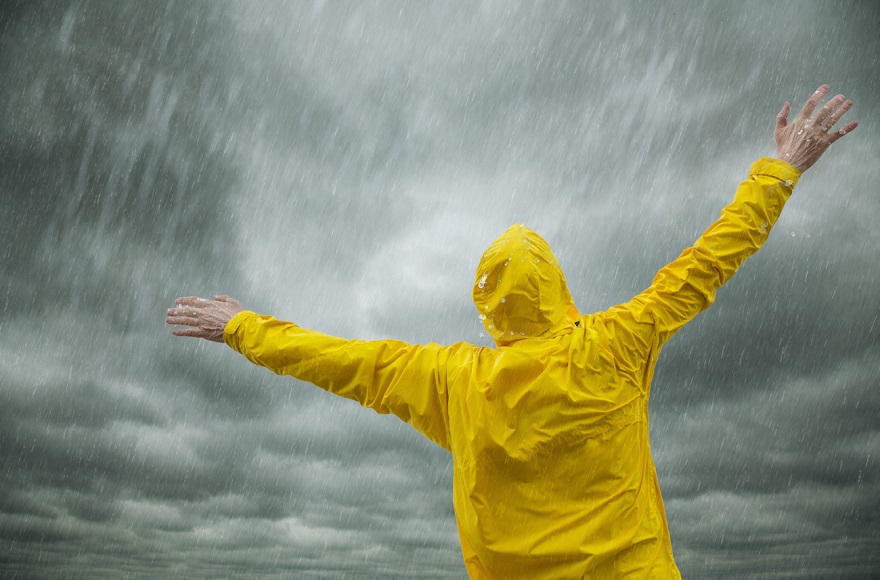NEW YORK (JTA) — You might not know it, but Shemini Atzeret is the pinnacle of the High Holidays season. Not Rosh Hashanah, when our fates for the year are traditionally written, nor Yom Kippur, when they are sealed. Shemini Atzeret, the oft-forgotten coda that comes at the end of the Sukkot festival, trumps them all.
That’s not just my opinion. The rabbis and ancient Israelites knew it, too.
According to the agrarian roots of the Jewish calendar, the date of Shemini Atzeret is timed to the start of the rainy season in Israel. In the holiday’s musaf (additional) service, we recite Tefillat Geshem, the prayer for rain, in which we ask God not only for rain but for the right amount of rain — “livracha velo liklala” (for a blessing and not a curse); rain that will sustain a people with fertile crops, not drown them in torrential floods.
Rosh Hashanah and Yom Kippur merely functioned as preparation for this precarious time. In the Yom Kippur Avodah service, the following prayer of the high priest is recited: “When the world is in need of rain, do not permit the prayers of the travelers with regard to rain to gain entrance before You.”
The prayers and sacrifices of the High Holidays were meant to prove our worth so that the harvest season continued smoothly and we merited rain once it was time to plant again. In ancient times, Sukkot opened with a water-drawing ritual, which by pouring out the remains of last year’s water symbolized faith that the coming year’s rains would fall just in time. Today we still beat willow branches on the last day of Sukkot, Hoshanna Rabba, pleading for salvation in the form of rain. Then, having completed a full week of waving the four species on Sukkot — each of which requires a significant amount of water to produce — we set it down and wait for the ultimate judgment.
READ: In off year for Israel, Morocco is etrog hot spot this Sukkot
It makes sense that Diaspora Jews tend not to focus on the agricultural roots of the High Holidays. As citizens of an industrialized society, praying for rain tends not to be at the top of our to-do lists. Most of us simply take it for granted that substantial food will be shipped in from wherever it can grow.

Sarah Chandler sees Shemini Atzeret as an awakening for Jews to recognize the sanctity of the Earth’s resources.
Theologically, we’ve moved away from this as well. Most contemporary religious ideologies no longer equate following God’s laws with receiving enough rain for our crops to survive. The Reform movement has even removed from its prayer books the second paragraph of the Shema, which links observance of the commandments to the provision of rain, to make the bold statement that as modern Jews we do not believe we can influence God to change the weather.
And yet, scientific research increasingly points to the fact that human actions can have an effect on the climate — and, in turn, the weather. Moreover, no matter how technologically advanced our society becomes, life as we know it will continue to depend on sufficient rainfall.
And so we should continue to say Tefillat Geshem — not because we believe that fasting and chest pounding will bring rain, but because it reminds us of the delicate balance necessary for life to thrive on this planet.
Our petitions to God are more than requests to act on our behalf. A responsible, modern religious ethos serves two seemingly contradictory functions: On the one hand, our request that God reward our weeks of repentance with the blessing of rain affirms our lack of dominion; on the other, calling out to God implores us to act by reminding us of our responsibilities.
In modern times, we need both scientists and activists telling us what to do as well as the faith that there are systems beyond our control. It is both a recognition and a release of our power.
A renewed recognition of ancient Judaism’s relationship to the earth has great potential to bring us closer to the rhythms of the seasons and, in turn, can lead to a more sustainable future for the planet.
The countdown to Shemini Atzeret can be an awakening for us to recognize the sanctity of our planet’s resources. Through honoring this often overlooked day, by calling out loud that rain should fall, we ask that our community be aligned with the natural cycles of the earth — for blessing and not for curse.
(Sarah Chandler is the manager of Farm Forward’s Jewish outreach campaign, which supports Jewish organizations in promoting conscientious food choices, reducing farm animal suffering and advancing sustainable agriculture. She previously was the director of the earth-based spiritual practice at Hazon’s Adamah Farm.)
JTA has documented Jewish history in real-time for over a century. Keep our journalism strong by joining us in supporting independent, award-winning reporting.






